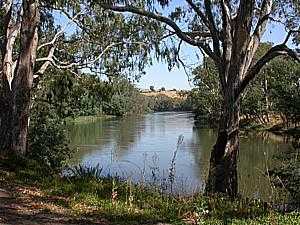Goulburn River
| Goulburn River | |
 Middle reaches of the Goulburn, near Seymour | |
| Country | Australia |
|---|---|
| Part of | Murray River, Murray-Darling basin |
| Tributaries | |
| - left | Big River, Rubicon River, Acheron River, Yea River, Sunday Creek |
| - right | Jamieson River, Howqua River, Delatite River, Broken River |
| Source | Victorian Alps |
| - location | near Woods Point, Victoria, Australia |
| - coordinates | 37°32′13″S 146°11′22″E / 37.53694°S 146.18944°E |
| Mouth | |
| - location | confluence with Murray River, near Echuca, Australia |
| - coordinates | 36°6′11″S 144°49′47″E / 36.10306°S 144.82972°E |
| Length | 654 km (406 mi) |
| Discharge | for Murray River |
| - average | 262 m3/s (9,252 cu ft/s) |
 Map showing the course of the Goulburn River and the major irrigation channel diverted from it
| |
The Goulburn River is a major inland river in Victoria, Australia.
The headwaters of the Goulburn rise in the western end of the Victoria Alps, near Woods Point and then it goes on to flow into the Murray River making it the longest river in Victoria at 654 kilometres (406 mi). The Eildon Dam creates Lake Eildon, a major storage of water for irrigation. From Lake Eildon, most of the irrigation water goes to Goulburn Weir and Waranga Basin.
Overview
South of Eildon near the town of Woods Point, the Goulburn rises at the slopes of Mount Matlock in the north-eastern plains of Victoria and eventually flows into the Murray River near Echuca making it the longest river in Victoria. The Goulburn also has the highest discharge of any river in Victoria. This area is a very productive irrigated agricultural area.[1] The Goulburn River was named after Henry Goulburn. There is also a Goulburn River in New South Wales.
Tributaries include the Broken, Rubicon, Delatite, Howqua, Jamieson and Yea Rivers.
Much of the flow is extracted, and the river is very heavily regulated, which has strongly affected the river's ecosystem. With recent years being some of the driest on record in the basin, there has been even further stress on the river's ecosystem.
Because of all this there has been much controversy over the construction of the North–South Pipeline, which will pipe 70 billion litres of water annually to Melbourne's water supply. There are arguments that all the water piped to Melbourne will be saved water, by the upgrade of the irrigation infrastructure in the Goulburn river basin all a part of a food bowl modernisation project.
In June 2008 the Murray-Darling Basin Commission released a report on the condition of the Murray-Darling basin, with the Goulburn and Murrumbidgee rivers both rated in a very poor condition in the Murray-Darling basin with fish stocks in both rivers were also rated as extremely poor.[2]
See also
References
- ↑ "Food Production in the Goulburn Murray Irrigation District"
- ↑ "Sustainable Rivers Audit" (PDF). Murray-Darling Basin Commission. June 2008. pp. 14, 30. Retrieved 2008-06-21.
External links
![]() Media related to Goulburn River at Wikimedia Commons
Media related to Goulburn River at Wikimedia Commons
| ||||||||||||||||||||||||||||||||||||||||||||||||||||||||||||||||||||||||||||||||